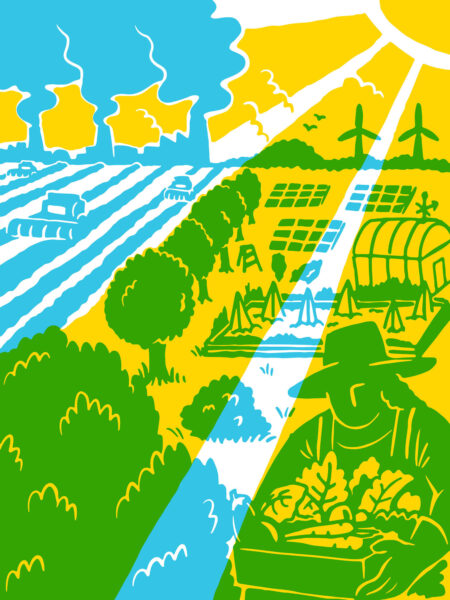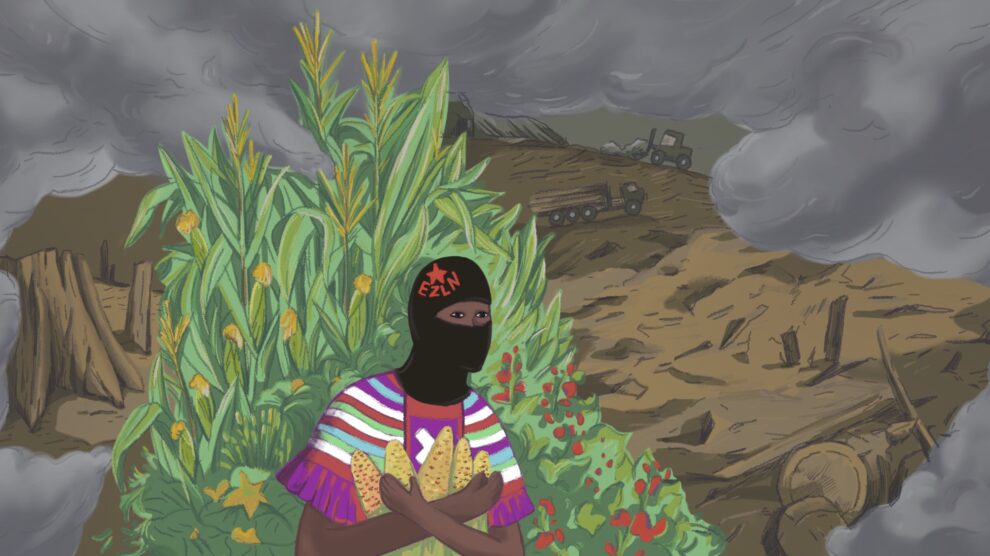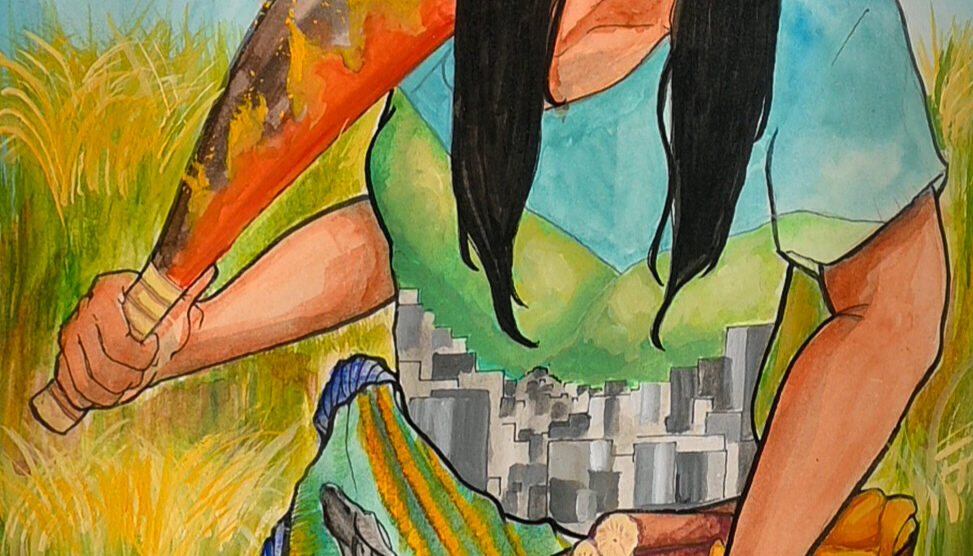A New Vision for American Agriculture: The Just and Equitable Transition Toward Agroecology
By Krista Marshall & Kelsey Brewer
Volume 23, number 2, A People’s Green New Deal

Industrial Agriculture Stands in Opposition to Ecology
The vast majority of food in markets today is produced through practices of industrial agriculture that rely heavily on mechanization, petrochemically derived inputs such as synthetic fertilizers and toxic pesticides, and genetic modification of crops for increased yields. This model of industrial agriculture has decimated global biodiversity and ecosystem functioning, polluted surrounding environments, and depleted soil fertility by inhibiting the recycling of constituent elements of the soil necessary for sustained long-term production.1 Industrial agriculture also emits substantial amounts of greenhouse gases, undermining its own long-term production stability through its contributions to global climate change.2 Under climate change, industrial agriculture has and will continue to decrease crop yields and the nutrient density of our foods.3 Moreover, the COVID-19 pandemic has renewed discussion on how the global expansion of industrial agriculture into adjacent forested lands may increase chances of global zoonotic disease epidemics, displacing complex natural ecosystems and creating contagion pipelines between previously undisturbed reservoirs of novel viruses and urban populated areas.4
The encumbrance of industrial agriculture and its contributions to global climate change and ecosystem collapse also disproportionately affect poor and working people of color.5 Industrial agriculture cannot be separated from its roots in the settler-colonial land theft from native peoples, nor the labor exploitation and environmental racism it perpetuates. Yet our economic and political system has never accounted for these racialized social costs, failing to provide justice and equity for the communities most impacted. This is even more evident under the current pandemic, where COVID-19 is holding a mirror to our industrial agriculture models and laying bare disparate ecological and sociopolitical systems that are highly vulnerable to disruptions in the environmental and cultural dynamics that govern them. For example, prolonged agricultural labor shortages, due to racist immigration policies and a pandemic-induced decline in food demand, have resulted in millions of pounds of food waste—yet food banks are currently seeing a sharp increase in demand for aid. Furthermore, squalid working conditions in large-scale animal processing factories have created new epicenters of the pandemic, highlighting the contradiction between industrial agriculture and community health. It is clear that the dominant agricultural paradigm requires radical and urgent transformation.6 A cohesive strategy for transforming this paradigm, then, must first articulate the foundations of its systemic exploitation. That system is capitalism.
Capitalism is based on a market system driven by a single motive force—profit-maximization. This market system is presupposed by a process of infinite growth and consumption within a world of finite and increasingly scarce resources, fundamentally contradicting the natural processes that govern these resources. Eco-Marxists outline the capitalist relationship with nature as one where the principle of restitution is replaced with a constantly reproduced and irreparable exploitation. This in turn alienates humanity from universal relationships with our natural environment—a concept known as the metabolic rift. Nothing is more emblematic of the metabolic rift than industrial agriculture. These production models have destroyed our natural ecosystems and accelerated global climate change, replacing previously complex and biodiverse landscapes with simplified, large-scale monocultures. The consolidation of farm ownership has concentrated land and resources, centralized and generalized decision-making, increased our dependence on petrochemical fertilizers and pesticides, and perpetuated the systematic exploitation of marginalized labor forces. Our agricultural system requires rapid shifts toward land stewardship, labor equity, and resource replenishment. Otherwise, we may undermine the conditions that sustain it, along with the viability of long-term food production and sovereignty.
Agroecology: Repairing the Rift Between Humanity and Our Natural Environments
Agroecology stands in contrast to industrialized agriculture by emphasizing the restoration of ecological functions and reconciliation of social and natural systems. Agroecological principles and practices are founded in our understanding of natural processes—namely, that biodiversity and productivity drive the (re)cycling of energy and nutrients while simultaneously supporting various ecologically-based benefits that society depends upon.7 By managing for enhanced biodiversity across multiple spatial scales—the farm, landscape, and region—agroecology facilitates complex interactions between humans, plants, animals, and soil microorganisms that are critical for building more multifunctional and resilient farming systems. These interactions are particularly important for maintaining the many and varied advantages that humans gain from our environments—a suite of provisioning, supporting, and regulating ecosystem functions that provide significant benefit for agricultural production and society at-large.
While industrial agriculture focuses exclusively on provisioning—referring to the production of material or energy outputs such as food, fiber, and fuel—it is the supporting and regulating functions, predominantly provided by biodiversity, that differentiate agroecological farming from its industrial counterpart. These supporting and regulating functions benefit surrounding communities—such as through abating environmental pollution, improving groundwater recharge and, importantly, mitigating climate change through large-scale greenhouse gas sequestration. They also aid in essential on-farm services to support crop health and agricultural productivity. For example, agroecological management can improve disease and pest suppression and crop pollination by supporting more complex ecological interactions, resources, and habitats for beneficial organisms such as bees and pest predators. Complex rotations of plants and animals within time and space can further utilize on-farm resources more efficiently, increase agricultural output, and reduce labor intensity through enhancing crop-livestock synergies.
Many of these supporting and regulating functions are facilitated by the organisms that compose the soil ecosystem—living plant roots, macro- and mesofauna, and microorganisms such as bacteria and fungi. As such, a central principle of agroecology is to prioritize the health and sustained fertility of soils. These healthy soils further aid in climate change mitigation by increasing greenhouse gas sequestration and the long-term accumulation of soil organic matter. This soil organic matter is essential for the many soil organisms that feed on and use its energy to facilitate decomposition, formation of soil structure, recycling and retention of on-farm water and nutrients, and plant symbiotic relationships that improve crop health and resilience to environmental stresses like drought. In tandem, these supporting and regulating functions can significantly improve the adaptation of farming systems to climate change, while reducing land degradation and the environmental impact of agriculture. As an alternative to the destructive, profit-driven practices of industrial agriculture, agroecology provides a wholistic and multifunctional approach for agriculture to repair some universal relationships with our natural environment.
Beyond the Field: Envisioning an Agroecological Food System Within the United States
Although previous attempts have been made to reduce agricultural exploitation across the United States, none have fundamentally addressed the socioeconomic paradigm underpinning current production models. For example, organic agriculture utilizes many agroecological practices but has been largely unsuccessful at transforming the socioeconomic structures that necessitated the movement’s origin. In fact, many organic operations are strikingly similar to the conventions of industrial systems—large-scale, consolidated monocultures supported by marginalized labor forces that substitute synthetic inputs for organic counterparts.8 The institutionalization of organic agriculture through certification protocols, price premiums, and the consolidation of organic production has also ensured that vested interests of capital remain central to agricultural production. These attempts aim to improve the “sustainability outcomes” of industrial agriculture, perpetuating the myth that this approach can be regenerative and resilient while continuing to maximize profitability.
Agroecology recognizes that socially just and ecologically complex agriculture can only be realized by transforming the socioeconomic power structures that control our food system. A transition toward agroecological farm models and away from our capitalist food system will require envisioning bold systemic transformations centered around community health and well-being, and thus should be prioritized within the Green New Deal (GND). This is predicated on the funding and formation of strong communities with networks of knowledge sharing and high degrees of local autonomy. A new agroecological model will require regional food systems that support diversified local farming as well as collective governance of the land, resources, and food supply chains that drive production and consumption.
First and foremost, an agroecological transition within the United States will require a substantial shift away from consolidated farm operations toward diverse communities of small to medium-scale farms with democratic ownership of land and resources—a strategy adopted by other global agroecology movements such as Campesino a Campesino, La Via Campesina, and Movimento dos Trabalhadores Sem Terra.9 The increasing consolidation of farmland has disincentivized land stewardship and coincided with increasing barriers to entry for young people and farmers of color.10 Continued investments in local land-trusts, transfer of land to beginning farmers, worker cooperatives, and rank-and-file empowerment of farm labor organizations and unions—such as the Labor Council for Latin American Advancement and United Farm Workers—can help to democratize agricultural land, resources, and profits.
Equitable access to and governance of farmland and natural resources is a particularly urgent objective to create opportunities for new farmers, especially given that the average US farmer is now over fifty-five years old. Further, people of color make up less than 8 percent of the farming community—1.7 percent and 1.3 percent for Indigenous and Black Americans, respectively—and two thirds of farmers identify as being men.11 Although some measures have been made to address the historic and systemic oppression and exclusion that underpin US agriculture, we have yet to realize comprehensive commitments to justice and equity—a Green New Deal platform will be key to achieving this outcome.12 This GND must also simultaneously abolish inhumane immigration policies to reflect economic, social, and political empowerment for agricultural laborers, many of whom hold intimate understandings of our agricultural landscapes and are essential to an agroecological transition. Enacting systems of democratic governance over farmland and resources will play a pivotal role in dismantling systems of oppression in agriculture and bolstering the financial and racial equity of farming, enhancing accessibility for new farmers and supporting the labor force expansion required for agroecological models.
The specialization and market consolidation of US agribusiness necessitates an economic model that disconnects production from regional food systems.13 This further perpetuates urban and rural food insecurity, diminishing community self-sufficiency and resilience.14 Agroecology as part of a just and equitable GND can only be realized through efforts to build regional and democratic food supply chains that link farmers directly with the food needs of their communities. The development and community control of local food infrastructure could be supported through mechanisms such as localized processing facilities, equitable distribution schemes, fair pricing, and expansion of regional market opportunities for local farmers. These agroecological food systems—from farmer to consumer—will not only require investment in local infrastructure and distribution schemes, but also an expansion of labor across the food supply chain. Whereas a common critique of, and perceived barrier to, agroecology is the increased labor intensity required to realize these systems, an agroecological transition could be positioned as an opportunity for safe and stable jobs—especially for historically excluded groups within the US—that bolster rural and urban livelihoods and create the meaningful employment central to a GND.15
Agroecology also underpins many social and racial justice movements happening at local levels across the country, as community-empowered agriculture is used both as a form of resistance to systemic exploitation and as a path toward community healing and justice. In California, anti-incarceration organizations such as Planting Justice and Three Sisters Gardens are transforming urban food systems by supporting and empowering previously incarcerated adults and vulnerable youth with skills training, access to equitable employment, and community building.16 Black community activists in Detroit also use farming as a form of resistance to capitalism, reclaiming swaths of urban land decimated by deindustrialization into productive community farms that produce healthy, culturally appropriate foods.17 Social and racial justice movements in rural farming communities across California’s Central Valley, such as the Community Alliance for Agroecology, have also used agroecological principles to bring about change for marginalized communities that experience some of the worst health, economic, and social outcomes under capitalism.
As we enter a pandemic-induced economic recession and global climate crisis that will continue to intensify, with disproportionate impacts on frontline and vulnerable working class communities, there is an urgent need to fundamentally transform agricultural production. A broad sweeping political platform, such as a Green New Deal, can facilitate this transformation and must place new agricultural models within a larger framework—one that boldly and foundationally changes our food system in a way that no longer externalizes the exploitation of land, resources, and people. Agroecology can serve as the framework for a new food system that recognizes that socially just and ecologically based agriculture can only result from movements that counter capitalism and enable the empowerment of community control over our food.
- Teja Tscharntke, Yann Clough, Thomas C. Wanger, Louise Jackson, Iris Motzke, Ivette Perfecto, John Vandermeer, and Anthony Whitbread, “Global Food Security, Biodiversity Conservation and the Future of Agricultural Intensification,” Biological Conservation 151, no. 1 (2012): 53–59.
- “Climate Change and Agriculture,” Union of Concerned Scientists, accessed May 4, 2020. https://www.ucsusa.org/resources/climate-change-and-agriculture.
- A. J. Challinor, J. Watson, D. B. Lobell, S. M. Howden, D. R. Smith, and N. Chhetri, “A Meta-Analysis of Crop Yield under Climate Change and Adaptation,” Nature Climate Change 4, no. 4 (2014): 287–91. https://doi.org/10.1038/nclimate2153
- Jason R. Rohr, Christopher B. Barrett, David J. Civitello, Meggan E. Craft, Bryan Delius, Giulio A. Deleo, Peter J. Hudson et al., “Emerging Human Infectious Diseases and the Links to Global Food Production,” Nature Sustainability 2, no. 6 (2019): 445–56. https://doi.org/10.1038/s41893-019-0293-3
- Courtney Lindwall, “U.N. Report: A Million Extinctions and Ecological Collapse Are on the Way.” Natural Resources Defense Council, April 28, 2020. https://www.nrdc.org/stories/report-million-extinctions-and-ecological-collapse-are-way; M. F. Núñez, “Environmental Racism and Latino Farmworker Health in the San Joaquin Valley, California,” Harvard Journal of Hispanic Policy 31 (2019): 9–14.
- Alejandra Borunda, “Past Decade Was the Hottest on Record,” National Geographic, January 15, 2020. https://www.nationalgeographic.com/science/2019/12/the-decade-we-finally-woke-up-to-climate-change/
- Miguel Altieri and Clara Nicholls, “Agroecology: a Brief Account of its Origins and Currents of Thought in Latin America,” Agroecology and Sustainable Food Systems 41, no. 3-4 (2017): 231-37.
- George Kuepper, “A Brief Overview of the History and Philosophy of Organic Agriculture,” Kerr Center, accessed April 25, 2020.
- Fergal Anderson, “Food Sovereignty Now! A Guide to Food Sovereignty,” European Coordination Via Campesina, accessed April 25, 2020, https://viacampesina.org/en/wp-content/uploads/sites/2/2018/02/Food-Sovereignty-A-guide-Low-Res-Vresion.pdf; Eric Holt-Giménez and Miguel Altieri, “Agroecology, Food Sovereignty, and the New Green Revolution,” Agroecology and Sustainable Food Systems 37, no. 1 (December 2012): 90–102.
- James M. MacDonald, Robert A. Hoppe, and Doris Newton, Three Decades of Consolidation in US Agriculture, EIB-189, US Department of Agriculture, Economic Research Service, March 2018.
- Laura Riley and Andrew Van Dam, “Advocates Hoped Census Would Find Diversity in Agriculture. It Found Old White People,” The Washington Post, April 13, 2020, https://www.washingtonpost.com/business/2019/04/13/advocates-hoped-new-report-would-find-diversity-ag-it-found-old-white-people/ .
- “Agriculture: Small- and Moderate-scale Diversified Farms and Ranches: Assistance Program,” California Legislature 2019-2020, accessed April 23, 2020, https://leginfo.legislature.ca.gov/faces/billNavClient.xhtml?bill_id=201920200AB838.
- Zoe Willingham and Andy Green, “A Fair Deal for Farmers,” Center for American Progress, accessed June 3, 2020, https://www.americanprogress.org/issues/economy/reports/2019/05/07/469385/fair-deal-farmers/.
- Ingo Zasada, Ulrich Schmutz, Dirk Wascher, Moya Kneafsey, Stefano Corsi, Chiara Mazzocchi, Federica Monaco, Peter Boyce, Alexandra Doernberg, Guido Sali and Annette Piorr, “Food Beyond the City—Analyzing Foodsheds and Self-sufficiency for Different Food System Scenarios in European Metropolitan Regions,” City, Culture, and Society 16 (March 2019): 25-35.
- Christian Timmermann and George Felix, “Agroecology as a Vehicle for Contributive Justice,” Agriculture and Human Values 32 (January 2015): 523-38; Cristiana Peano and Francesco Sottile, “Social Challenges and Agroecology: The Data,” December 2017, accessed June 1, 2020.
- “Planting Justice,” Planting Justice, accessed May 4, 2020, https://plantingjustice.org/.
- Monica White, “Sisters of the Soil: Urban Gardening as Resistance in Detroit,” Race/Ethnicity: Multidisciplinary Global Context 5, no. 1 (Fall 2011): 13–28.




